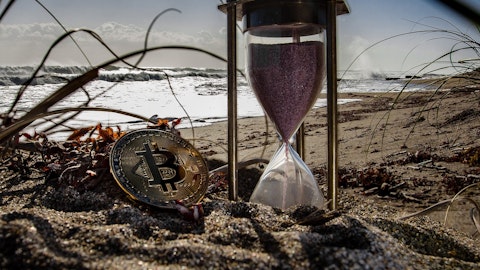Alesia Haas: Experimentation has long been part of our product strategy and increasingly part of our pricing strategy to experiment around which model works best for our customers. So for example, Coinbase One started as a pricing experiment in many ways, and we’re proud to see the continued growth of Coinbase One in many quarters. As we shared in Q1 of this year, we raised fees on our spread within Simple Trading, and we did not see any change in our customer behavior as a result of that. And so then just to answer your question is, we may increase, we may decrease in other products and we will continue to learn what works best for our customers over time ultimately to drive engagement and revenue on our platform. And speaking of just Emilie’s comment on ETFs, what we wanted to say very specifically is that is not necessarily a driver.
The driver is overall customer engagement with our products, overall competitive environment broadly, and we take all of that as input to inform our strategies and pricing experiments.
Operator: Your next question comes from the line of Owen Lau with Oppenheimer. Your line is open.
Owen Lau: Good afternoon and thank you for taking my question. So you continue to manage the expense down sequentially, even though your headcount, I think it’s higher in the third quarter compared to the second. Your expense guidance indicates that it will continue to go down in the fourth quarter because of stock-based comp? And Alesia, you also mentioned some guidance in the first quarter as well. But can you please talk about if there’s any other levers you can pull to manage or expand? And also, how will international expansion and other growth initiatives will impact your expense growth in the near term? Thank you.
Alesia Haas: Thanks, Owen. As we said this year, our focus has been on financial discipline and prudent allocation of our expenses. The underlying theme here around stock-based compensation is it has a non-linear expense recognition. And so if you look back a quarter what we shared with you is that the first half stock-based compensation was going to be very similar to the second half, although Q3 and Q4 were going to have different levels. And so driving the Q4 expense is a lot of the reduction in stock-based comp that we just see natural seasonally occurring in the fourth quarter. Broadly, though, the international growth and new product innovation is all within the expense envelope and outlook that we provided for Q4. We’ve shared with you before our approach to allocating our expenses aligned with a 70-20-10 model or 70 – roughly 70% of our resources is going to our core products, 20% is strategic and 10% to our venture kind of newest product initiatives that are very early stage.
Brian’s talked a lot about the importance of a company of a lot of innovation and fail fast, so we continue to try and experiment with new things. So that’s all included in that outlook, and we feel really good about our ability to continue to invest in growth, invest in innovation while generating positive adjusted EBITDA and building a company that’s more financially efficient.
Operator: Your next question comes from the line of John Todaro with Needham & Company. Your line is open.
John Todaro: Great. Thanks for taking my question. Sorry for asking another one on the take rate. But I just wanted to understand, so advance going down versus simple. Is it the understanding that advanced users for some reason, are using a simple interface or are advanced users leaving the platform maybe to go to Dexus or some other trading venue?
Alesia Haas: In general, what we see in low volatility environments, is less trading from advanced users from market makers and participants that are looking for arbitrage opportunities across the ecosystem and across the variety of exchanges. So this is more of a comment on the overall volatility environment and the opportunity to make appropriate trade in this environment than it is around losing customers or them switching platforms.
Operator: Your next question comes from the line of Bo Pei with US Tiger Securities. Your line is open.
Bo Pei: Hi. Good afternoon management. Thanks for taking the question. So two, if I may. So given our emphasis on on-chain activity, what is the max move to further build our on-chain product portfolio, do you plan to launch any debt yourself or just focusing on developing the infrastructure? And then second, not follow-up on the retail spreads. So do we charge different spreads for different digital assets? Is Bitcoin trading spread lower than the overall average on our platform? Thank you.
Alesia Haas: I’ll answer the ticky-tacky on fees, and I’ll let Brian then talk about the future of on-chain product road maps. Pricing experiments at this point in time historically have really been by product, but in the future, we may evaluate different pricing experiments by coins of geographies as well. So all of those are opportunities. But historically, they’ve been largely by product.
Brian Armstrong: Yes. So thanks for asking about the move to on-chain. So obviously, with the introduction of Base, we’re making a big investment there. And one of our next major efforts is going to be how to integrate that into all of our products. And I’m really making a push internally to get more and more of the activity on Coinbase happening on-chain. So there’s a few areas where we’ve been doing that to date. Coinbase Wallet is our self-custodial wallet. So all of the transactions happening there are on-chain. That’s where we saw over 1 million while it’s being active on Base in the last month. Things like Coinbase Commerce are putting efforts into how more and more of this can happen on Layer 2 on-chain. Actually, we created some end-to-end metrics internally, where we look at all the transactions happening on the Coinbase platform.





